Data-Driven Distributionally Robust Optimization-Based Coordinated Dispatching for Cascaded Hydro-PV-PSH Combined System
Abstract
:1. Introduction
2. Data-Driven DRO-Coordinated Dispatch Model
2.1. Objective Function
2.2. Constraints
2.2.1. Day-Ahead Dispatch Constraints
- 1.
- Power Balance Constraintwhere is the system load power of each state in period t.
- 2.
- Operation Constraints of the Cascaded Hydropower
- Water Storage Variation Constraint of Reservoirwhere, in period t, signifies the reservoir’s water capacity, while and represent the maximum and minimum capacity of the ii-th reservoir, respectively.
- Output Constraintwhere denotes the lowest acceptable output value for the i-th cascaded hydropower station.
- Discharging Flow Constraintwhere denotes the outflow rate from the i-th reservoir during a specific period. and represent the maximum and minimum outflow rates.
- Water Volume Balance Constraintwhere , and are reservoir inflow, flow of power generation, and outflow from the i-th reservoir.
- Constraint related to hydraulic connectivity between stageswhere and represent the delay factors associated with the water flow between stages and the interval inflow between stages.
- Limit on the rate of change in output power for the hydraulic turbinewhere and denote the minimum and maximum rates of change in output for the cascaded hydropower system.
- 3.
- Constraints on the Output of PV Station
- 4.
- Operation Constraints of PSH
- Restriction on the Fluctuation of Reservoir Water Storagewhere , and are the upper reservoir’s water storage volume in period t, and the maximum and minimum reservoir capacities of the i-th PSH station, respectively; , , are the lower reservoir’s water storage volume in period t, and the maximum and minimum reservoir capacities of the i-th PSH station, respectively.
- Water Volume Balance ConstraintConstraint in Generation StateConstraint in Pumping Statewhere and are the generation efficiency and pumping efficiency of PSH, respectively.
- Constraints of Generation Power and Pumping Powerwhere and are the minimum and maximum generation power of the ith PSH station, respectively. and are the minimum and maximum pumping power of the ith PSH station, respectively.
- Electricity Balance Constraint of Generation and Pumping
- Ramp Rate Constraint of PSHwhere and are the minimum and maximum variation speed of generation power, and and are the minimum and maximum variation speed of pumping power, respectively.
- Operating State Mutual Exclusion Constraint
- 5.
- Grid Flow ConstraintThe DC power flow constraints in the literature [32] are taken as the grid flow constraint of the hybrid system. Each branch flow should meet the following (32):For each branch, represents the DC power flow, with , as the admittance coefficient matrix and the node connection matrix of the network branch. Furthermore, , , , , and serve as vector representations for the purchased power, cascaded system output, PV system output, PSH system pumping power, PSH system generation power, and load demand during period tttt, respectively. and denote the PSH pumping state vector and generation state vector during period t, respectively. stands for the maximum branch power, is the reactance of the ll-th branch, and zz indicates the branch number in the network.
- 6.
- Reserve ConstraintsThe complementary generation system’s requirements for upward and downward reserve capacity are fulfilled by the cascaded hydropower system and the PSH system. The system’s reserve requirement is calculated as the sum of the partial output from PV and the partial output from the cascaded hydropower, as specified in the Equations (33) and (34):where represents the spinning reserve factor for PV output, set at 10% in this context, and is the spinning reserve factor for the cascaded hydropower system, set at 4%.
2.2.2. Real-Time Dispatch Constraints
- Regulated Power Balance Constraint
- Operation Constraints of the Cascaded Hydropower
- Water Storage Regulated Variation Constraint of Reservoirwhere is the water storage regulated variation of the ith reservoir under the kth scenario in period t.
- Regulated Output Constraint
- Regulated Discharging Flow Constraintwhere is the regulated discharging flow of the ith reservoir under the kth scenario in period t.
- Regulated Water Volume Balance Constraintwhere , and are the regulated inflow, regulated generation flow, and regulated discharging flow of the ith reservoir under kth scenario in period t, respectively.
- Interstage Hydraulic Connection Constraint
- Ramp Rate Constraint of Hydraulic Turbine
- Output Constraints of PV station
- Operation Constraints of PSH
- Water Storage Regulated Variation Constraint of Reservoirwhere and are upper reservoir regulated water storage and lower reservoir regulated water storage of the ith PSH station in period t, respectively.
- Regulated Water Volume Balance ConstraintConstraint in Generation StateConstraint in Pumping State
- Constraints of Regulated Generation Power and Regulated Pumping Power
- Regulated Electricity Balance Constraint of Generation and Pumping
- Ramp Rate Constraint of PSH
- Operating State Mutual Exclusion Constraint
- Grid Flow Constraintwhere , , and are the vector forms of regulated purchased power, regulated output power of the cascaded system, regulated pumping power of PSH, and regulated generation power of PSH under the kth scenario in period t respectively.
- Reserve Constraints
2.2.3. Data-Driven Comprehensive Norm Constraints
3. Solution Algorithm for the Dro Dispatch Model
3.1. Linear Treatment for Comprehensive Norm Constraints
3.2. Model Solution for DRO Coordinated Dispatch
4. Numerical Study
4.1. The Influence of Data Size
4.2. The Influence of Confidence Coefficient
4.3. Comparative Study
5. Conclusions
- (1)
- A data-driven DRO two-stage dispatching model was established to meet the dispatching requirements of CHPP system, and an efficient C&CG algorithm was introduced to divide the model into MP and SP for iterative cycling calculation.
- (2)
- The conservativeness of the DRO dispatching model is inversely proportional to data size, and proportional to the comprehensive norm confidence level. It is further verified that DRO algorithm organically integrates the advantages of SO and RO, and the algorithm achieves a better robustness (Unit Average Cost: ¥ 138.7216/MWh) than SO (¥ 137.9051/MWh), and a better economy than RO (¥ 191.3382/MWh).
- (3)
- The DRO-coordinated dispatching method for the CHPP system can realize the dispatching performance of the probabilistic chronologic production simulation method while improving calculation efficiency. In the same calculation scale, the DRO can save 18.6% calculating time, and achieved a higher efficiency.
Author Contributions
Funding
Data Availability Statement
Conflicts of Interest
References
- Wang, H.; Qi, Y.; Wang, C.; Huang, Y.; Wang, Y. Two-Stage Stochastic Optimal Scheduling Model Considering Flexible Load. Power Syst. Technol. 2018, 42, 3669–3675. (In Chinese) [Google Scholar]
- Chen, Y.; Zhang, Z.; Chen, H.; Zheng, H. Robust UC model based on multi-band uncertainty set considering the temporal correlation of wind/load prediction errors. IET Gener. Transm. Distrib. 2020, 14, 180–190. [Google Scholar] [CrossRef]
- Chen, Y.; Zhang, Z.; Liu, Z.; Zhang, P.; Ding, Q.; Liu, X.; Wang, W. Robust N-k CCUC model considering the fault outage probability of units and transmission lines. IET Gener. Transm. Distrib. 2019, 13, 3782–3791. [Google Scholar] [CrossRef]
- Liu, Y.; Guo, L.; Wang, C. Economic Dispatch of Microgrid Based on Two Stage Robust Optimization. Proc. CSEE. 2018, 38, 4013–4022+4307. (In Chinese) [Google Scholar]
- Zhang, Z.; Chen, Y.; Ma, J.; Liu, X.; Wang, W. Two-Stage Robust Security Constrained Unit Commitment Considering the Spatiotemporal Correlation of Uncertainty Prediction Error. IEEE Access 2019, 7, 22891–22901. [Google Scholar] [CrossRef]
- Zhang, Z.; Chen, Y.; Liu, X.; Wang, W. Two-Stage Robust Security-Constrained Unit Commitment Model Considering Time Autocorrelation of Wind/Load Prediction Error and Outage Contingency Probability of Units. IEEE Access 2019, 7, 25398–25408. [Google Scholar] [CrossRef]
- Niknam, T.; Azizipanah-Abarghooee, R.; Narimani, M.R. An efficient scenario-based stochastic programming framework for multi-objective optimal micro-grid operation. Appl. Energy 2012, 99, 455–470. [Google Scholar] [CrossRef]
- Heitsch, H.; Roemisch, W. Scenario tree modeling for multistage stochastic programs. Math Program. 2009, 118, 371–406. [Google Scholar] [CrossRef]
- Wu, L.; Shabidehpour, M.; Li, T. Stochastic security-constrained unit commitment. IEEE Trans. Power Syst. 2007, 22, 800–811. [Google Scholar] [CrossRef]
- Pozo, D.; Contreras, J. A Chance-Constrained Unit Commitment with an n-K Security Criterion and Significant Wind Generation. IEEE Trans. Power Syst. 2013, 28, 2842–2851. [Google Scholar] [CrossRef]
- Odetayo, B.; Kazemi, M.; MacCormack, J.; Rosehart, W.D.; Zareipour, H.; Seifi, A.R. A Chance Constrained Programming Approach to the Integrated Planning of Electric Power Generation, Natural Gas Network and Storage. IEEE Trans. Power Syst. 2018, 33, 6883–6893. [Google Scholar] [CrossRef]
- Ning, C.; You, F. Data-driven stochastic robust optimization: General computational framework and algorithm leveraging machine learning for optimization under uncertainty in the big data era. Comput. Chem. Eng. 2018, 111, 115–133. [Google Scholar] [CrossRef]
- Zhang, S.; Yuan, J.; Cheng, H.; Li, K. Optimal Distributed Generation Planning in Active Distribution Network Considering Demand Side Management and Network Reconfiguration. Proc. CSEE 2016, 36, 1–9. (In Chinese) [Google Scholar]
- Growe-Kuska, N.; Heitsch, H.; Romisch, W. Scenario reduction and scenario tree construction for power management problems. In Proceedings of the 2003 IEEE Bologna Power Tech Conference, Bologna, Italy, 23–26 June 2003. [Google Scholar]
- Wang, J.; Shahidehpour, M.; Li, Z. Security-constrained unit commitment with volatile wind power generation. IEEE Trans. Power Syst. 2008, 23, 1319–1327. [Google Scholar] [CrossRef]
- Zhou, R.; Min, X.; Tong, X.; Chen, R.; Li, X.; Liu, Z. Distributional Robust Optimization Under Moment Uncertainty of Environmental and Economic Dispatch for Power System. Proc. CSEE 2015, 35, 3248–3256. (In Chinese) [Google Scholar]
- Zhu, G.; Lin, J.; Luo, Z.; Dai, S.; Qin, L.; Liu, C. Review of Robust Optimization for Generation Scheduling in Power Systems. Proc. CSEE 2017, 37, 5881–5892. (In Chinese) [Google Scholar]
- Shang, C.; You, F. Distributionally robust optimization for planning and scheduling under uncertainty. Comput. Chem. Eng. 2018, 110, 53–68. [Google Scholar] [CrossRef]
- Zhai, Q.; Zhou, Y.; Li, X.; Wu, J.; Xu, Z.; Xie, X. Nonanticipativity and All-Scenario-Feasibility: State of the Art, Challenges, and Future in Dealing with the Uncertain Load and Renewable Energy. Proc. CSEE 2020, 40, 6418–6433. (In Chinese) [Google Scholar]
- Nemirovski, A.; Shapiro, A. Convex approximations of chance constrained programs. SIAM J. Optim. 2007, 17, 969–996. [Google Scholar] [CrossRef]
- Wang, Q.; Guan, Y.; Wang, J. A Chance-Constrained Two-Stage Stochastic Program for Unit Commitment with Uncertain Wind Power Output. IEEE Trans. Power Syst. 2012, 27, 206–215. [Google Scholar] [CrossRef]
- Qiu, W.; Zhang, J.; Liu, N. Model and Solution for Environmental/Economic Dispatch Considering Large-scale Wind Power Penetration. Proc. CSEE 2011, 31, 8–16. (In Chinese) [Google Scholar]
- Yu, J.; Ren, J.; Zhou, M. A Chance-Constrained Programming Based Dynamic Economic Dispatch of Wind Farm and Pumped-Storage Power Station. Power Syst. Technol. 2013, 37, 2116–2122. (In Chinese) [Google Scholar]
- He, S.; Gao, H.; Liu, J.; Liu, Y.; Wang, J.; Xiang, Y. Distributionally Robust Optimal DG Allocation Model Considering Flexible Adjustment of Demand Response. Proc. CSEE 2019, 39, 2253–2264+8. (In Chinese) [Google Scholar]
- Xiong, P.; Jirutitijaroen, P.; Singh, C. A Distributionally Robust Optimization Model for Unit Commitment Considering Uncertain Wind Power Generation. IEEE Trans. Power Syst. 2017, 32, 39–49. [Google Scholar] [CrossRef]
- Shui, Y.; Liu, J.; Gao, H.; Qiu, G.; Xu, W.; Gou, J. Two-stage Distributed Robust Cooperative Dispatch for Integrated Electricity and Natural Gas Energy Systems Considering Uncertainty of Wind Power. Autom. Electr. Power Syst. 2018, 42, 43–50+75. (In Chinese) [Google Scholar]
- Delage, E.; Ye, Y. Distributionally Robust Optimization Under Moment Uncertainty with Application to Data-Driven Problems. Oper. Res. 2010, 58, 595–612. [Google Scholar] [CrossRef]
- Zhou, R.; Ren, Q.; Min, X.; Zheng, Q.; Wu, X.; Wang, Y. Frequency Regulation Ratio Decision-making of Multi-generator Based on Modified Distributional Robust Optimization under Moment Uncertainty. Electr. Power Autom. Equip. 2019, 39, 130–137. (In Chinese) [Google Scholar]
- He, S.; Ruan, H.; Gao, H.; Liu, J. Overvier on Theory Analysis and Application of Distributionally Robust Optimization Method in Power System. Autom. Electr. Power Syst. 2020, 44, 179–192. (In Chinese) [Google Scholar]
- Yang, Y.; Wu, W. A Distributionally Robust Optimization Model for Real-Time Power Dispatch in Distribution Networks. IEEE Trans. Smart Grid 2019, 10, 3743–3752. [Google Scholar] [CrossRef]
- Bai, M.; Yang, Z. Distributionally Robust Self-Scheduling Optimization with CO2 Emissions Constraints under Uncertainty of Prices. J. Appl. Math. 2014, 2014, 356527. [Google Scholar] [CrossRef]
- Gao, H.; Liu, J.; Wei, Z.; Cao, Y.; Wang, W.; Huang, S. A Security-Constrainted Dispatching Model for Wind Generation Units Based on Extreme Scenario Set Optimization. Power Syst. Technol. 2013, 37, 1590–1595. (In Chinese) [Google Scholar]
- Ding, T.; Yang, Q.; Yang, Y.; Li, C.; Bie, Z.; Blaabjerg, F. A Data-Driven Stochastic Reactive Power Optimization Considering Uncertainties in Active Distribution Networks and Decomposition Method. IEEE Trans. Smart Grid. 2018, 9, 4994–5004. [Google Scholar] [CrossRef]
- Zhao, C.; Guan, Y. Data-Driven Stochastic Unit Commitment for Integrating Wind Generation. IEEE Trans. Power Syst. 2016, 31, 2587–2596. [Google Scholar] [CrossRef]
- Ben-Tal, A.; Goryashko, A.; Guslitzer, E.; Nemirovski, A. Adjustable robust solutions of uncertain linear programs. Math. Program. 2004, 99, 351–376. [Google Scholar] [CrossRef]
- Bertsimas, D.; Brown, D.B.; Caramanis, C. Theory and Applications of Robust Optimization. SIAM Rev. 2011, 53, 464–501. [Google Scholar] [CrossRef]
- Zeng, B.; Zhao, L. Solving two-stage robust optimization problems using a column-and-constraint generation method. Oper. Res. Lett. 2013, 41, 457–461. [Google Scholar] [CrossRef]
- Grigg, C.; Wong, P.; Albrecht, P.; Allan, R.; Bhavaraju, M.; Billinton, R.; Chen, Q. The IEEE reliability test system–1996. IEEE Trans. Power Syst. 1999, 14, 1010–1018. [Google Scholar] [CrossRef]
- Zhang, S.; Yang, J.; Gao, H.; Liu, J.; Liu, J. Probabilistic Chronological Production Simulation-Based Coordinated Dispatching for Cascaded Hydro-PV-PSH Combined Power Generation System. Math. Probl. Eng. 2020, 2020, 6677301. [Google Scholar] [CrossRef]

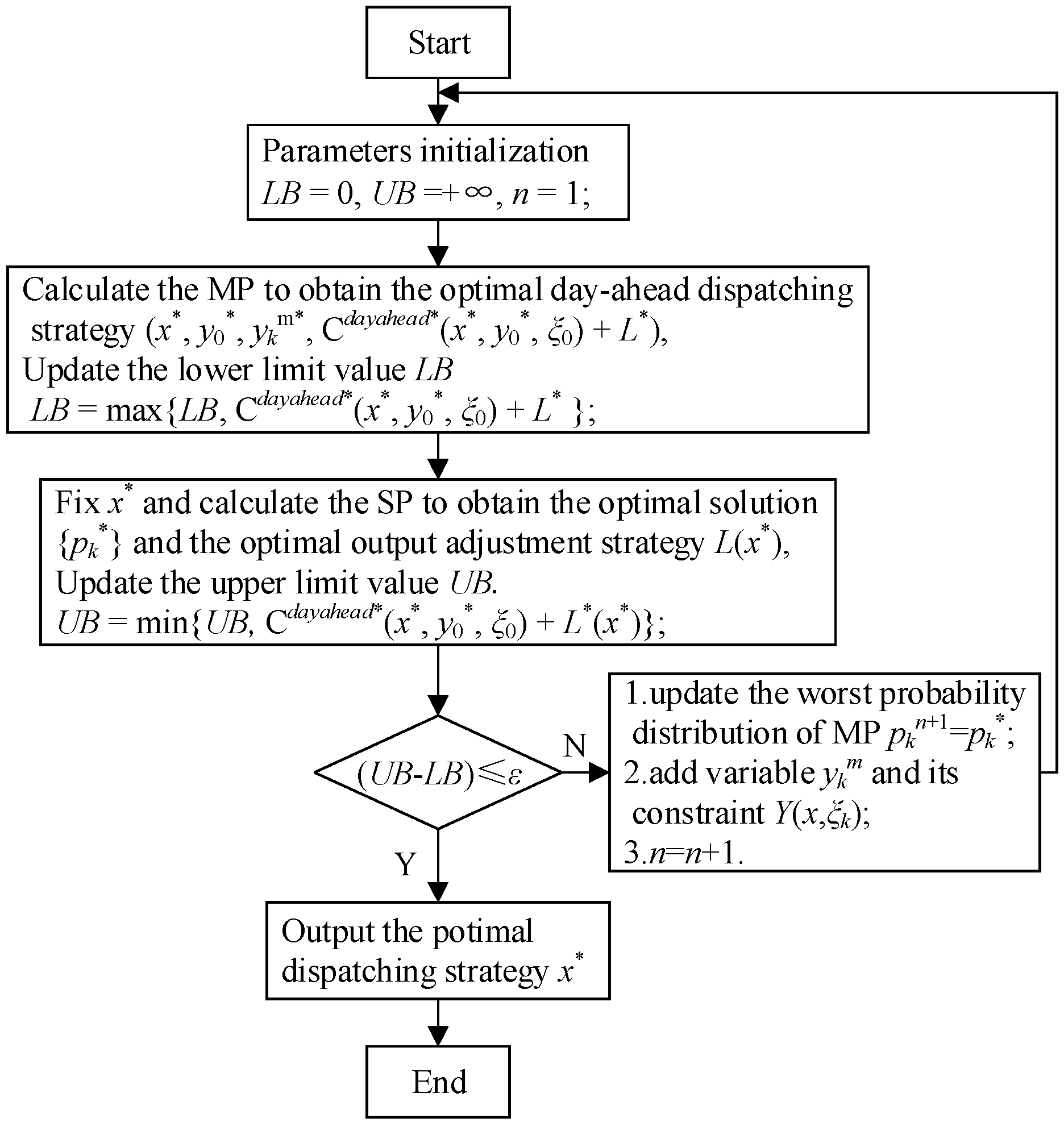

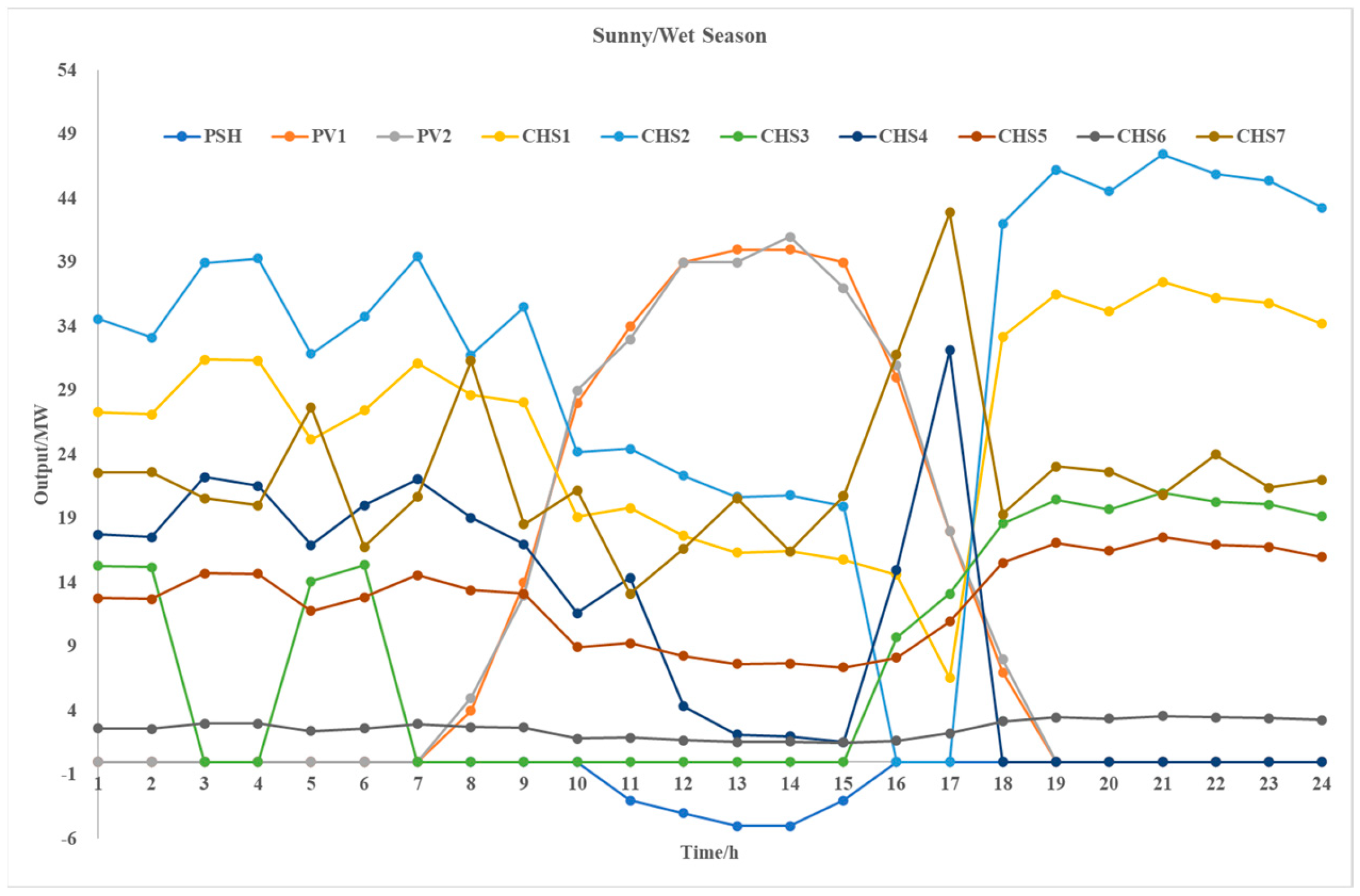
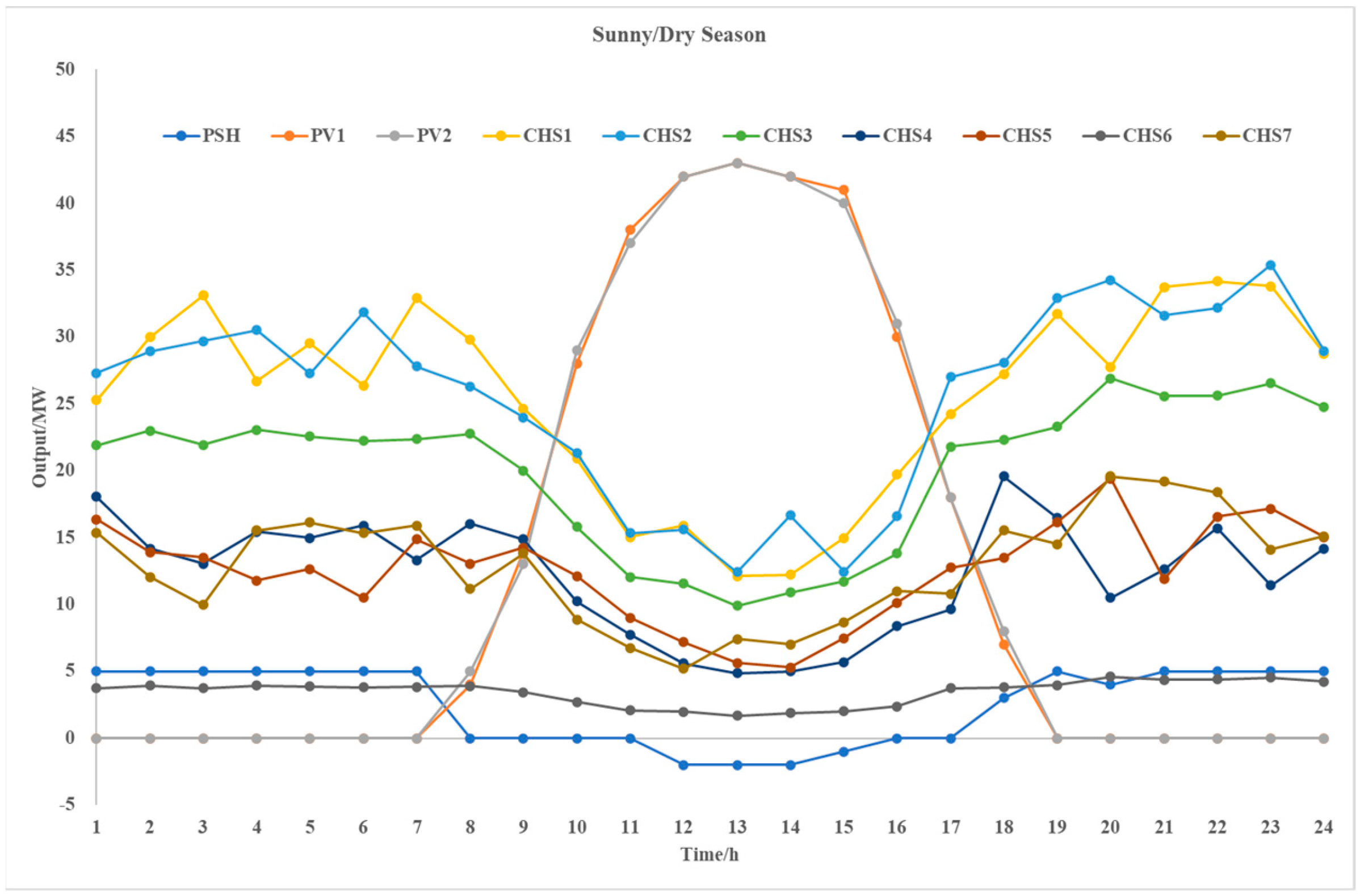
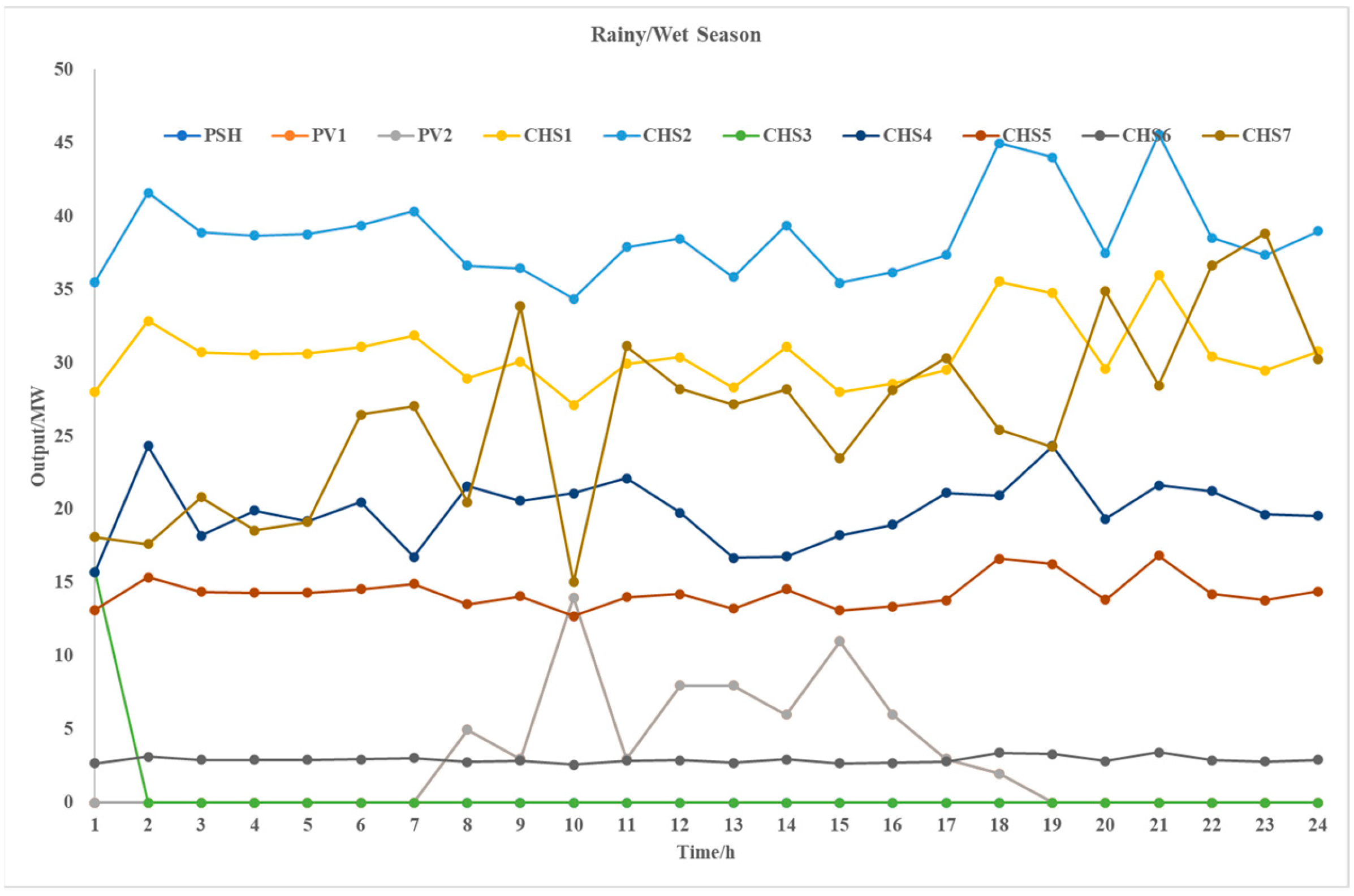
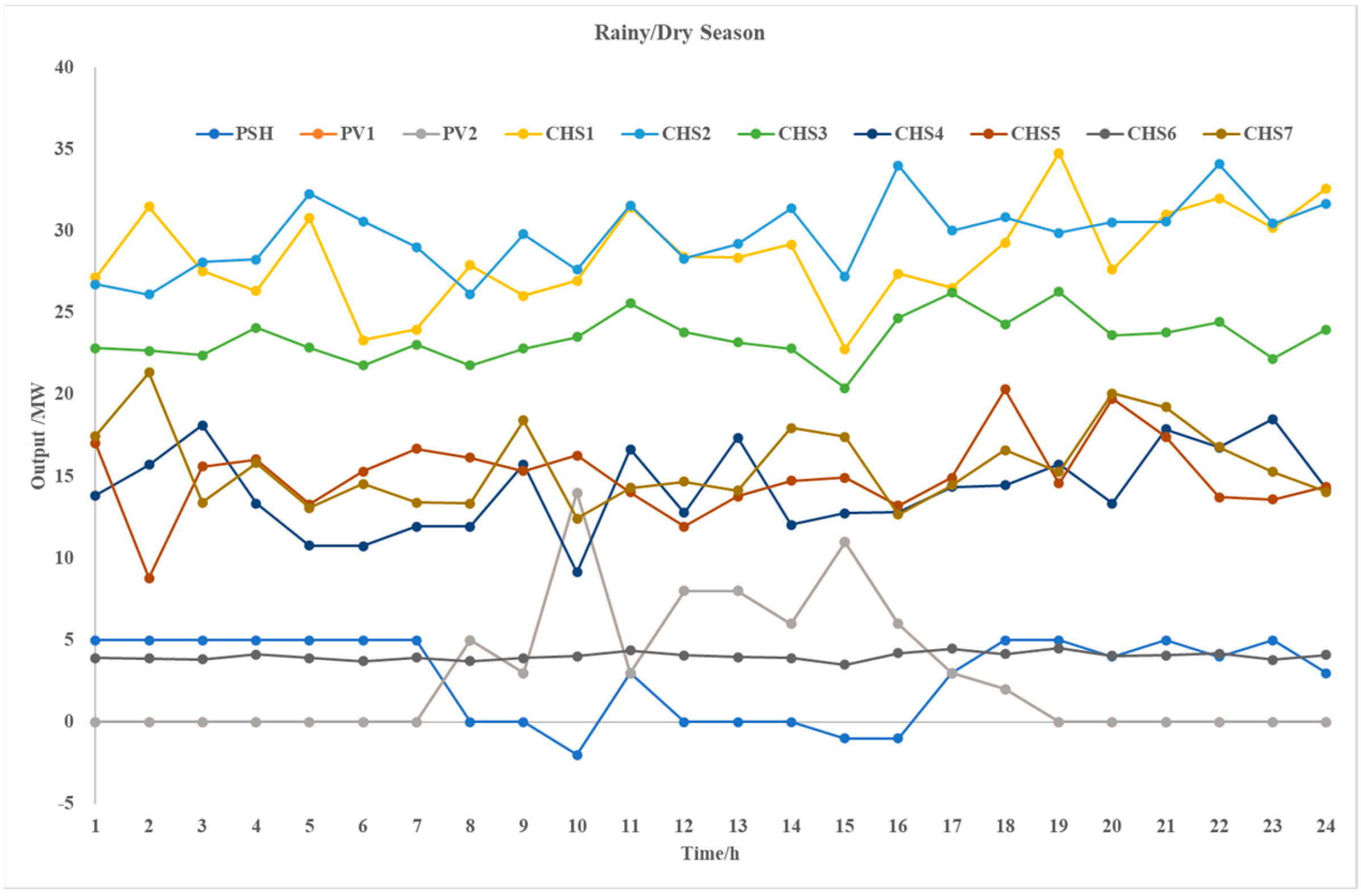
| Node | Station Type | Installed Capacity /MW | Reservoir Capacity /104 m3 | Power Generation Head/m | Working Flow /m3/s |
|---|---|---|---|---|---|
| 1# | PV 1 | 50 | - | - | - |
| 2# | PV 2 | 50 | - | - | - |
| 7# | CHS 5 | 20 | - | 339.09 | 7.4 |
| 13# | CHS 3 | 36 | 37.2 | 91 | 33 |
| 14# | - | - | - | - | - |
| 15# | CHS 6 | 4.8 | 53 | 10.5 | 48.9 |
| 16# | PSH | 5 | 25.6/23.7 | 339.09 | 7.4 |
| 18# | CHS 2 | 60 | 20.9 | 127 | 53.4 |
| 21# | CHS 4 | 54 | 25.6 | 161 | 47.1 |
| 22# | CHS 1 | 45 | 16.1 | 123.65 | 43.32 |
| 23# | CHS 7 | 84 | 44.2 | 75 |
| Time/h | PV Stations | Cascaded System | Local Load | ||
|---|---|---|---|---|---|
| Sunny | Rainy | Wet Season | Dry Season | ||
| 1 | 0 | 0 | 290.62 | 160.44 | 134 |
| 2 | 0 | 0 | 292.44 | 153.56 | 134 |
| 3 | 0 | 0 | 275.18 | 161.22 | 133 |
| 4 | 0 | 0 | 283.08 | 151.88 | 133 |
| 5 | 0 | 0 | 290.6 | 156.44 | 132 |
| 6 | 0 | 0 | 287.32 | 152.59 | 132 |
| 7 | 0 | 0 | 297.48 | 153.4 | 134 |
| 8 | 4.53 | 4.86 | 288.06 | 145.71 | 137 |
| 9 | 14.23 | 3.6 | 292.25 | 163.51 | 141 |
| 10 | 28.69 | 14.69 | 269.49 | 147.82 | 140 |
| 11 | 34.57 | 3.97 | 296.45 | 162.09 | 139 |
| 12 | 39.76 | 8.1 | 287.71 | 160.08 | 140 |
| 13 | 40.24 | 8.68 | 293.47 | 149.98 | 138 |
| 14 | 40.03 | 6.24 | 282.16 | 164.76 | 138 |
| 15 | 39.5 | 11.83 | 291.02 | 152.99 | 138 |
| 16 | 30.84 | 6.98 | 282.7 | 148.82 | 138 |
| 17 | 18.15 | 3.58 | 289.05 | 151.72 | 138 |
| 18 | 7.53 | 2.13 | 282.85 | 148.37 | 139 |
| 19 | 0 | 0.1 | 276.96 | 154.21 | 140 |
| 20 | 0 | 0 | 269.63 | 152.03 | 140 |
| 21 | 0 | 0 | 286.37 | 146.95 | 140 |
| 22 | 0 | 0 | 298.45 | 158.84 | 140 |
| 23 | 0 | 0 | 292.73 | 162.34 | 139 |
| 24 | 0 | 0 | 293.8 | 151.65 | 137 |
| Data Size/pcs | Average Cost/¥/MWh |
|---|---|
| 100 | 221.0963 |
| 500 | 144.7245 |
| 1000 | 138.7216 |
| 2000 | 125.6966 |
| 5000 | 122.9082 |
| 10,000 | 109.9088 |
| Types/¥/MWh | = 0.50 | = 0.75 | = 0.99 |
|---|---|---|---|
| = 0.30 | 138.4412 | 138.9613 | 139.1146 |
| = 0.60 | 138.8901 | 139.0761 | 139.2721 |
| = 0.90 | 139.1626 | 139.4247 | 139.4837 |
| Types | DRO | SO | Traditional RO |
|---|---|---|---|
| Unit Average Cost /¥/MWh | 138.7216 | 137.9051 | 191.3382 |
| Types | DRO | Probabilistic Chronologic Production Simulation |
|---|---|---|
| Unit Maximum Cost/¥/MWh | 146.8864 | 151.2611 |
| Unit Average Cost/¥/MWh | 138.7216 | 138.6383 |
| Calculation Time/s | 58.3 | 71.6 |
Disclaimer/Publisher’s Note: The statements, opinions and data contained in all publications are solely those of the individual author(s) and contributor(s) and not of MDPI and/or the editor(s). MDPI and/or the editor(s) disclaim responsibility for any injury to people or property resulting from any ideas, methods, instructions or products referred to in the content. |
© 2024 by the authors. Licensee MDPI, Basel, Switzerland. This article is an open access article distributed under the terms and conditions of the Creative Commons Attribution (CC BY) license (https://creativecommons.org/licenses/by/4.0/).
Share and Cite
Zhang, S.; Qiu, G.; Liu, Y.; Ding, L.; Shui, Y. Data-Driven Distributionally Robust Optimization-Based Coordinated Dispatching for Cascaded Hydro-PV-PSH Combined System. Electronics 2024, 13, 667. https://doi.org/10.3390/electronics13030667
Zhang S, Qiu G, Liu Y, Ding L, Shui Y. Data-Driven Distributionally Robust Optimization-Based Coordinated Dispatching for Cascaded Hydro-PV-PSH Combined System. Electronics. 2024; 13(3):667. https://doi.org/10.3390/electronics13030667
Chicago/Turabian StyleZhang, Shuai, Gao Qiu, Youbo Liu, Lijie Ding, and Yue Shui. 2024. "Data-Driven Distributionally Robust Optimization-Based Coordinated Dispatching for Cascaded Hydro-PV-PSH Combined System" Electronics 13, no. 3: 667. https://doi.org/10.3390/electronics13030667






